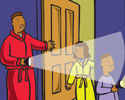Fire Prevention
Fire Facts
~ In 2008, U.S. fire departments responded to 386,500 home fires. These fires killed 2,755 civilians. Eighty-three percent of all fire deaths resulted from home fires.
~ Someone was injured in a home fire every 40 minutes and roughly eight people died in home fires every day during 2008.
~ A fire department responded to a home fire ever 81 seconds.
~ Almost two-thirds of reported home fire deaths in 2003-2006 resulted from fires in homes with no smoke alarms or no working smoke alarms.
~ About 1/3 of home fires and deaths happened in the months of December, January and February.
~ Cooking continues to be the leading cause of home fires and home fire injuries.
~ Smoking materials caused one of every four home fire deaths.
~ The kitchen is the leading area of origin for home fires. However, bedrooms and living/family rooms are the leading areas of origin for home fire deaths.
Burns
~ Burn injuries result in hundreds of thousands of emergency room visits a year. Thermal burns outnumber scalds nearly two-to-one.
Cooking
~ Cooking is the leading cause of home fires, accounting for 40% of reported home fires and 36% of related injuries.
~ Unattended cooking is the leading cause of cooking fires.
~ U.S. fire departments responded to 146,400 home structure fires involving cooking equipment in 2005. These fires caused 480 civilian fire deaths, 4,690 civilian fire injuries and $876 million in direct property damage.
~ Twelve percent of the fires occurred when something that could catch fire was too close to the equipment.
Smoking
~ Smoking materials (i.e., cigarettes, cigars, pipes, etc.) are the leading cause of fire deaths (roughly one in four) in the United States.
~ There were 142,900 smoking-material fires in the United States in 2006, causing 780 civilian deaths and 1,600 civilian injuries.
~ Older adults are at the highest risk of death or injury from smoking-material fires even though they are less likely to smoke than younger adults.
~ The most common items first ignited in home smoking-material fire deaths were upholstered furniture and mattresses or bedding.
~ One out of four victims of fatal smoking-related fires is not the smoker whose cigarette started the fire.
Heating
~ In 2006, heating equipment was involved in an estimated 64,100 reported home structure fires, 540 civilian deaths, 1,400 civilian injuries, and $943 million in direct property damage.
~ In 2006 heating equipment fires accounted for 16% of all reported home fires (second behind cooking) and 21% of home fire deaths.
~ More than half of all heating related fire deaths in 2003-2006 resulted from fires in December, January, and February.
~ Space heaters result in far more fires and losses than central heating devices and have higher risks relative to usage.
~ Fixed or portable space heaters were involved in 4% of the home fires and 17% of the home fire deaths.
~ Most of the space heater fires were caused by the space heater being too close to things that could burn.
Electrical
~ Electrical distribution or lighting equipment was involved in 25,100 reported home structure fires in 2006. These fires caused 370 deaths.
~ Lamps, light fixtures and light bulbs accounted for 5,500 home structure fires per year, during 2003-2006.
~ Wiring switches or outlets caused more than 10,000 home fire structures per year. Cord or plugs accounted for 2,600. Cords and plugs accounted for 1% of the home fires and 5% of home fire deaths.
Intentional Fires
~ In 2003-2006 17,900 intentionally set home structures fires were reported each year, resulting in 320 deaths and $542 million in property loss.
~ Roughly half of the people arrested for arson are under age 18.
Smoke Alarms
~ Smoke alarms that are properly installed and maintained play a vital role in reducing fire deaths and injuries. Having a working smoke alarm cuts the chances of dying in a reported fire in half.
~ A 2008 U.S. telephone survey found that 96% of U.S. households had at least one smoke alarm, yet in 2003-2006, no smoke alarms were present or none operated in two out of the five (41%) of the reported home fires.
~ Almost two-thirds of reported home fire deaths in 2003-2006 resulted from fires in homes with no smoke alarms or no working smoke alarms.
~ No smoke alarms were present in 40% of the home fire deaths.
~ In more than half of the reported home fires in which the smoke alarms were present but did not operate, batteries were missing or disconnected. Nuisance alarms were the leading reason for disconnected smoke alarms.

Home Escape Planning
~ According to an NFPA survey, only one in four Americans have actually developed and practiced a home fire escape pln to ensure they could escape quickly and safely.
~ While 66% of Americans have an escape plan in case of a fire, only 35% of those have practiced it.
~ One-third of American households who made an estimate thought they would have at least 6 minutes before a fire in their home would become life-threatening. The time available is often less. And only 8% said their first thought on hearing a smoke alarm would be to get out!
~ Eighteen to 24-year-olds are the least likely to have even developed an escape plan.

Commemorating a Conflagration
Fire Prevention Week was established to commemorate the Great Chicago Fire, the tragic 1871 conflagration that killed more than 250 people, left 100,000 homeless, destroyed more than 17,400 structures and burned more than 2,000 acres. The fire began on October 8, but continued into and did most of its damage on October 9, 1871.
According to popular legend, the fire broke out after a cow – belonging to Mrs. Catherine O’Leary – kicked over a lamp, setting first the barn, then the whole city on fire. Chances are you’ve heard some version of this story yourself; people have been blaming the Great Chicago Fire on the cow and Mrs. O’Leary, for more than 130 years. But recent research by Chicago historian Robert Cromie has helped to debunk this version of events.
The ‘Moo’ myth
Like any good story, the ‘case of the cow’ has some truth to it. The great fire almost certainly started near the barn where Mrs. O’Leary kept her five milking cows. But there is no proof that O’Leary was in the barn when the fire broke out – or that a jumpy cow sparked the blaze. Mrs. O’Leary herself swore that she’d been in bed early that night, and that the cows were also tucked in for the evening.
But if a cow wasn’t to blame for the huge fire, what was? Over the years, journalists and historians have offered plenty of theories. Some blamed the blaze on a couple of neighborhood boys who were near the barn sneaking cigarettes. Others believed that a neighbor of the O’Leary’s may have started the fire. Some people have speculated that a fiery meteorite may have fallen to earth on October 8, starting several fires that day – in Michigan and Wisconsin, as well as in Chicago.

The Biggest Blaze That Week
While the Great Chicago Fire was the best-known blaze to start during this fiery two-day stretch, it wasn’t the biggest. That distinction goes to the Peshtigo Fire, the most devastating forest fire in American history. The fire, which also occurred on October 8th, 1871, and roared through Northeast Wisconsin, burning down 16 towns, killing 1,152 people, and scorching 1.2 million acres before it ended.
Historical accounts of the fire say that the blaze began when several railroad workers clearing land for tracks unintentionally started a brush fire. Before long, the fast-moving flames were whipping through the area ‘like a tornado,’ some survivors said. It was the small town of Peshtigo, Wisconsin that suffered the worst damage. Within an hour, the entire town had been destroyed.
Eight Decades of Fire Prevention
Those who survived the Chicago and Peshtigo fires never forgot what they’d been through; both blazes produced countless tales of bravery and heroism. But the fires also changed the way that firefighters and public officials thought about fire safety. On the 40th anniversary of the Great Chicago Fire, the Fire Marshals Association of North America (today known as the International Fire Marshals Association), decided that the anniversary of the Great Chicago Fire should henceforth be observed not with festivities, but in a way that would keep the public informed about the importance of fire prevention. The commemoration grew incrementally official over the years.
In 1920, President Woodrow Wilson issued the first National Fire Prevention Day proclamation, and since 1922, Fire Prevention Week has been observed on the Sunday through Saturday period in which October 9 falls. According to the National Archives and Records Administration’s Library Information Center, Fire Prevention Week is the longest running public health and safety observance on record. The President of the United States has signed a proclamation proclaiming a national observance during that week every year since 1925.
